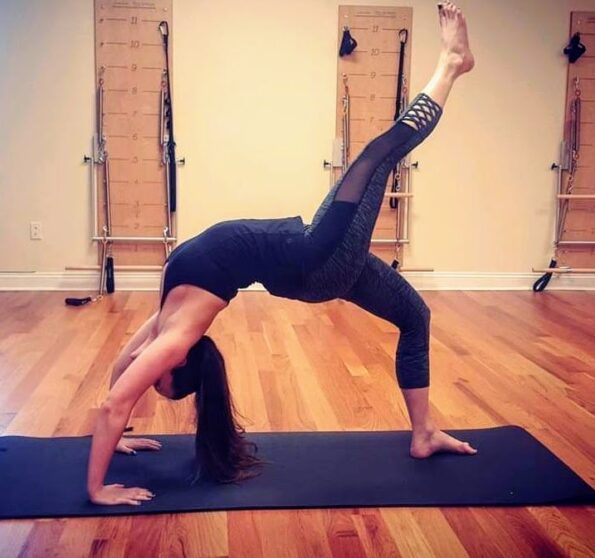Exercise can improve flexibility, strength, balance, energy levels, mood, and self-esteem.
Working out doesn’t need to be complicated or daunting. The Department of Health and Human Services recommendations for healthy adults is to get at least 150 minutes of moderate aerobic activity a week along with muscle strengthening exercises that increase or maintain musculoskeletal health. The guidelines are similar for people with disabilities but are based on ability.1 If that sounds overwhelming to you, break it up into smaller increments of 10 minutes minimum of exercise at a time. Aim for 20 minutes a day, or 30 minutes, five days a week. The bottom-line is to get your body moving!
Getting started can be as simple as walking your dog, doing a few squats while watching TV, or even walking to your mailbox! The goal is moderate-intensity activity, which is anything that gets your heart-rate up to 50-60% higher than it’s rate while at rest.2
If you want to make sure your level of exertion stays at a moderate intensity, do the talk test. You should be able to talk without being out of breath.
Here are some examples of moderate aerobic activity:3,4
- Walking briskly, approximately 3 miles per hour (2 miles in 30 minutes)
- Easy hike on a nature trail
- Riding a bike, slower than 10 miles per hour
- Water aerobics for 30 minutes
- Swimming laps for 20 minutes
- Stationary bike-moderate effort
- Jumping rope for 15 minutes
- Gardening for 30-45 minutes
- Dancing for 30 minutes
- Raking leaves for 30 minutes
- Walking up and down stairs for 15 minutes
- Household chores like vacuuming
- Tai Chi, Yoga or Pilates
- Play golf
- Weight training
Exercising with Limited Mobility
You don’t need to have full mobility to reap the benefits of exercise. A physical therapist can evaluate your strengths, limitations, and levels of fitness and structure and safe and effective fitness program. According to Dr. Mercola of Peak Fitness, if someone is able to stand, low-impact exercises like walking, tai chi, swimming, and yoga might be good options. If a person needs to be seated while exercising, chair yoga, or modified tai chi might be considered.5
Researchers report resistance training may slow down the progression of Multiple Sclerosis by protecting the nervous system against the disease. In a 2017 study published in the Multiple Sclerosis Journal, physical training seems to have a protective effect on the brain. Patients already on MS medication who did resistance training showed a tendency for less brain shrinkage. The researchers also noted several smaller brain areas that started to grow in response to resistance training.6
This sort of research leaves me hopeful that one day it will be the norm to encourage people living with Multiple Sclerosis to practice physical fitness as a vital part of their treatment plan. In the meantime, experts agree that strength training can build bone mass and muscle; improving balance. Flexibility exercises like stretching can help loosen stiff and tight muscles, giving a person a better range of motion and aerobic activity can improve endurance. Another great bonus is that exercise releases endorphins that help with mood and stress.
Before starting any new exercise routines, always seek the advice of a medical professional.
Find out what kind of exercise may be suitable. Ask how often you should exercise and at what pace. Remember, with MS, it’s important not to get overheated. During hot weather, aim to exercise in the morning when it’s cooler and you’re likely to have more energy. Or exercise in air conditioning. Think about the activity you are considering and the environment in which it’s practiced. If it won’t work for you, think of alternatives. For example, hot yoga is not a good idea if you are heat sensitive, but there is regular yoga and arm-chair yoga as alternatives.
Here are some helpful hints:
- Start with an activity you enjoy
- Go at your own pace
- Gradually increase your activity level
- Schedule exercise on your calendar to hold yourself accountable
- Track your progress
- Celebrate your success! It will keep you motivated.
Don’t beat yourself up if your best intentions don’t go according to plan. If you are having a bad week with MS symptoms, or life in general, just do what you can. Something is better than nothing. Regardless of your starting point, you can improve. The aim is to just move your body.
Consider these questions for inspiration:
What exercise or physical activity would you like to try?
- How would it feel if you engaged in this activity regularly?
- How would you benefit?
- Is there anything stopping you from getting started?
- How will you overcome this obstacle?
- What will you commit to right now to get your body moving?
Start somewhere!
Photo credit- Thanks Janine Lalancette for the photo and the inspiration!
1 https://www.ncbi.nlm.nih.gov/pmc/articles /PMC3405391/ 2,3 https://health.clevelandclinic.org/what-does-moderate-exercise-mean-anyway/ 4https://www.cdc.gov/physicalactivity/basics/measuring/index.html 5 https://fitness.mercola.com/sites/fitness/archive/2015/12/04/limited-mobility-exercises.aspx 6 www.neurosciencenews.com/MS-resistance-trainin-7220/
